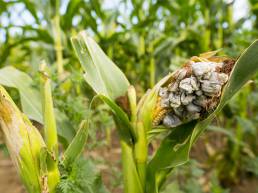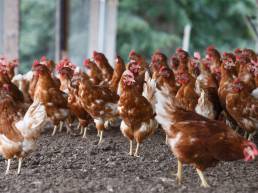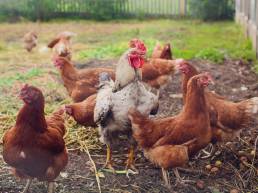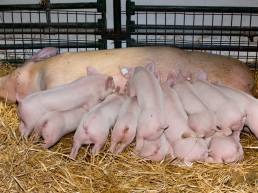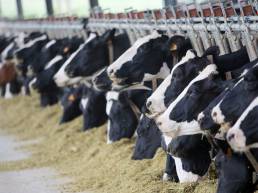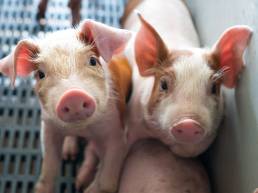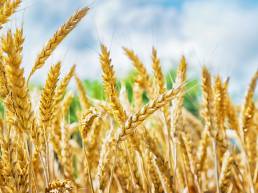Following a good start at the end of July the harvest season is still in full swing. After a dry spring and a changeable start of the summer (followed by an extreme heatwave) harvest prognoses were positive.
For the 2020/2021 season the International Grains Council (IGC) expects a total grain harvest of 2,22 billion tons due to lower yields in the U.S., Russia and the EU. Human consumption is expected to remain unchanged and demand from the compound feed sector will probably be lower. It will not lead to a shortage on the global market.
Due to global uncertainty wheat prices showed an upward trend until July and then they fell by well over €20.00 per 100 kgs. The market seemed to be recovering slightly in the beginning of August with a minor uptick, but do these prices say anything about the quality and quantity of the harvests? Or is the market reacting to the current crisis?
Mycotoxins
In the beginning of August various sources reported an increased risk of DON in corn and wheat in Europe with levels in excess of 150 ppb. Corn also has an increased risk of the presence of mycotoxins FUM and ZEA. This prediction is based on weather conditions and the forecasts for August. Mycotoxin levels will be higher in winter wheat than in summer wheat as a result of the cold and wet weather conditions at the end of July. Correct storage also plays an important role in the prevention of mycotoxin formation. High moisture content and a high temperature can cause storage fungi, leading to an increase in mycotoxin levels in grains.
The importance of mycotoxin prevention and control
Mycotoxins are toxic fungal metabolisms. There are over 400 different mycotoxins and the presence of higher levels or certain combinations of mycotoxins has a harmful effect on the animal.
Even low levels of ZEA, for example, can affect fertility, ochratoxin often causes hepatic and renal necrosis and the level of mycotoxin Aflatoxin B1 in dairy cattle is monitored continually because of its carcinogenic effect.
It is not possible to grow 100% mycotoxin-free crops, as many external factors affect them, such a weather and harvest conditions. Due to the many adverse health effects of mycotoxins it important to protect animals and consequently humans from their harmful effects. Therefore E.F.S. has developed its product Tox-Aid®. Tox-Aid® has a three-stage effect: it deactivates mycotoxins by means of enzymes, it consists of various clay minerals that bind mycotoxins and it contains a special mixture of herbs that support the animal’s liver and immune system.
Would you like to hear more? Please contact us!
You may also like
Tox-Aid® organic authorisation
June 29, 2020
Tox-Aid® is on the organic input list! Tox-Aid® has been authorised for use in organic feeds to limit the negative effects of mycotoxins in the animal. This product has a three-stage effect, i.e. deactivation by means…
Corn smut in maize silage and its threat to animal health
August 26, 2018
At the moment a lot of corn smut (field fungus) is found in maize fields as a result of prolonged drought, sometimes combined with sprinkler irrigation this growing season (2018).
Tox-Aid®: The deactivation of Enniatin B
September 15, 2017
In line with our motto ‘inspired by nature, scientifically proven’ mycotoxin Enniatin B1 has been analysed by means of in vitro tests. Enniatins are a group of mycotoxins that is relatively unknown, but increasingly…
Tox-Aid®: Also deactivates Fumonisin and Ochratoxin
May 20, 2017
Tox-aid® is a natural solution that deactivates mycotoxins. In three steps mycotoxins in the animal are rendered harmless. E.F.S. believes nature has a solution for everything. However, this also needs to be…
Tox-Aid®: Masked Mycotoxins
January 28, 2017
E.F.S. believes that nature has a solution for everything. Mycotoxins are part of a natural process and it appears that masked mycotoxins are present in crops, feed materials and feed. Maybe you have already heard the…
Mycotoxins
August 16, 2016
Nowadays, adequately controlling the growth of bacteria and fungi is possible, but mycotoxins still pose a risk due to their impact on animal health. In practice, mycotoxins still often seem to be forgotten. However,…
Tox-Aid®: Mycotoxins in dairy farming
July 23, 2016
Mycotoxins are an underestimated problem in livestock. More knowledge has been gained in the past few decades about fungi, mycotoxins and their effects. Therefore fungi are more and more recognised as a problem at…
Effects of Tox-Aid® on the performances of piglets
December 9, 2014
Tox-Aid® is a mixture of inactivated yeast, bentonite and plant extracts. The aim of the product is deactivation and binding of mycotoxins in the digestion tract of the animal.
E.F.S. launches Tox-Aid®
October 1, 2013
Although mycotoxins are relevant throughout the year, this is definitely the time to pay extra attention to this subject. New harvests are just around the corner. As of today, E.F.S. is bringing its own product against…
Should we worry about mycotoxins in dairy feed?
May 23, 2011
Cows are capable of detoxifying limited amounts of mycotoxins in the rumen. This is on condition that the cow's rumen works properly. However, some mycotoxins have a very negative impact on the rumen flora which…





